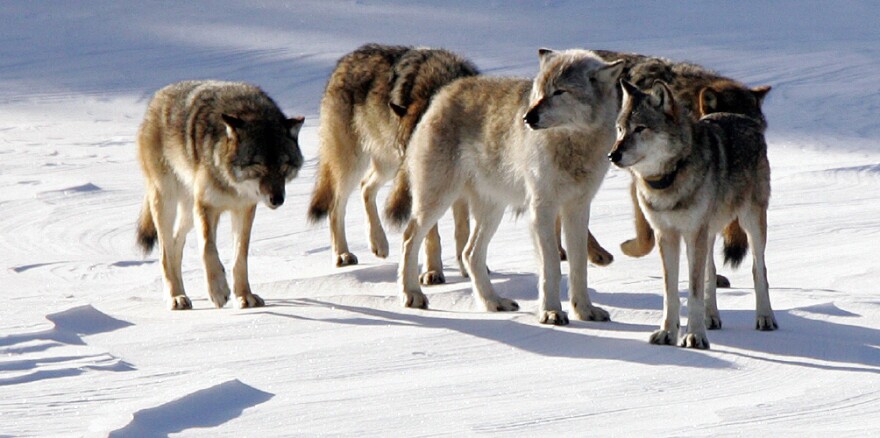Much of what the world knows about wolves and their behavior comes from the long term research taking place on Isle Royale.
For 54 straight years, humans have been closely watching the top predator here, wolves - and their favorite prey, moose.
Durward Allen from Purdue first started the study in 1958. It was originally designed as a ten-year project.
Rolf O. Peterson joined the project after it had been running for 12 years. And under Peterson's leadership at Michigan Tech, the project continued from there.
The film Fortunate Wilderness by George Desort takes a close look at the wolf-moose study on Isle Royale.
In it, Yellowstone wolf project leader Doug Smith said he can't imagine the science of ecology without the Isle Royale wolf-moose project.
"I think Isle Royale is the best example of how you need that long term work, because we're at a point now scientifically where everything is subtle. Everything is in the details," said Smith. "Things are changing rapidly too with threats like global warming and what not. And we need baselines."
Protected wolves of Isle Royale hanging by a thread
Rolf Peterson is now retired (Michigan Tech's John Vucitech now leads the project), but he's still an active "volunteer" as he describes it.
The research on Isle Royale has led to a better understanding of wolves, and how their presence helps put nature back in balance.
It has also helped to shift the public's attitude toward the predators.
Once hunted to near extinction, wolves are making a comeback in the West, Southwest, and the Upper Midwest.
But here on Isle Royale, the population has gone from a high of 50 animals in 1980, to just nine today.
- Six wolves in the "Chippewa Harbor Pack,"
- Two wolves in the "West-end Duo,"
- and one lone wolf.
Here's Rolf Peterson describing the current state of the wolf population on Isle Royale. (In the video, Peterson mentions of the nine wolves left, there is only one female that is in a breeding situation. There is one other female wolf they know about, but she's not of breeding age yet.)
http://www.youtube.com/watch?v=HbtbWKKE1tY&list=UUiO61Z2BTd18ovzJ4syJJpQ&index=1&feature=plcp
What's leading to the decline?
Peterson points out several things that could be leading to the decline of wolves on Isle Royale.
"The wolf population has been sinking from about 30 to 9 over the last 6 years. There are about four possible causes:
- Disease - canine parvo virus came back in 2007 about the time the decline started. That’s a pretty potent wolf disease;
- Shortage of food because of the age structure of the moose population. There’s a rapidly declining number of old moose in the population right now. Old moose support wolves.
- Then, random demographic chance – sex ratio may be a roll of the dice. Births and deaths go up and down. Births, deaths, and sex ratio combine to produce a disaster at times.
- Finally genetics – this is a heavily inbred population. We don’t know all the things that go along with that because probably everything about each animal is somehow affected by that inbreeding. They’d be very vulnerable to new diseases because they’re all genetically similar," said Peterson.
Ice bridges not forming as often
The wolves on Isle Royale first came to the island over an ice bridge in the late 1940s. Lake Superior was frozen between the island and the mainland of Ontario and Minnesota. Wandering wolves made the 25 mile trek from the mainland to the island back then.
And in the intervening years, DNA analysis of wolf scat has shown that other wolves have made the trek, but the likelihood of more wolves making it across is becoming less likely as the climate warms.
Peterson points out that it takes several days of zero degree Fahrenheit temperatures, and calm winds - a condition that is becoming a lot less likely. From the Wolf-Moose 2012 Annual Report:
In the 1960s an ice bridge formed two out of three winters, on average, while in the 2000s ice bridges formed about one year in ten.
Should a wilderness be untouched?
Most of Isle Royale National Park is designated as "wilderness." It's a federal policy that protects wild places across the country.
Humans cannot intervene in these wild places. But climate change raises the question, if humans are responsible for a warming climate, aren't we intervening in a negative way already? And if that's the case, should we intervene to restore a balance on Isle Royale should the wolf population go extinct?
John Vucitech, of Michigan Tech, said Isle Royale is an example of a big important question for wilderness all across the United States.
"There really is not one square inch that humans haven't heavily impacted, including our wilderness areas. These human impacts are probably just an occasion for us to kind of re-think what is our relationship with nature, what is our relationship with wilderness areas in particular. And Isle Royale, and this question of what to do if wolves go extinct, is going to play an important role in leading our thoughts to that new stage," said Vucitech.
Legacy of the wolf-moose research on Isle Royale
Peterson said he feels if the island were eventually left without wolves, he feels his years of research would have gone unnoticed.
"If we haven’t convinced everybody that wolves are important to the integrity of this island, in other words, they’d be allowed to go extinct and left wolf-less, then obviously we haven’t accomplished much," said Peterson. "So I would be most satisfied if indeed the answer was, 'of course, we've got to put them back - they’re so critical as 50 years of science suggest they are.'"
The National Park Service is just beginning the discussion of what to do should the wolves disappear from this Lake Superior archipelago.






